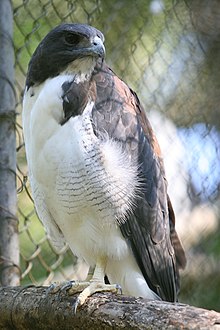White-tailed hawk
| White-tailed hawk | |
|---|---|
 |
|
| Adult at Salvador Zoo, Ondina, Salvador, Bahia, Brazil | |
| Scientific classification | |
| Kingdom: | Animalia |
| Phylum: | Chordata |
| Class: | Aves |
| Order: | Accipitriformes |
| Family: | Accipitridae |
| Genus: | Geranoaetus |
| Species: | G. albicaudatus |
| Binomial name | |
|
Geranoaetus albicaudatus Vieillot, 1816 |
|
| Synonyms | |
|
Buteo albicaudatus |
|
Buteo albicaudatus
The white-tailed hawk (Geranoaetus albicaudatus) is a large bird of prey species found in tropical or subtropical environments across the Americas.
The white-tailed hawk is a large, stocky hawk. It is close in size to the Swainson's and red-tailed hawks, its mean measurements falling slightly ahead of the first and slightly behind the latter. It can attain a total length of 44–60 cm (17–24 in) and a wingspan of 118–143 cm (46–56 in). A body mass of 880–1,240 g (1.94–2.73 lb) was reported in B. a. hysopodius and 865–1,010 g (1.907–2.227 lb) in B. a. colonus. Among standard measurements, the wing chord is 39–46.2 cm (15.4–18.2 in), the tail is 19.4–22 cm (7.6–8.7 in) and the tarsus is 8–9.2 cm (3.1–3.6 in). Adult birds are grey above and white below and on the rump, with faint pale grey or rufous barring. The short tail is white with a narrow black band near the end that is conspicuous in flight. A rusty-red shoulder patch is just as characteristic when the bird is sitting with wings closed. The wings are dark above, admixed with grey near the bases of the blackish primary remiges. The underwing is whitish, with indistinct brownish barring on the underwing coverts that extends onto the flanks and thighs. The iris is hazel, the cere is pale green, the beak is black with a horn-colored base, and the feet are yellow with black talons.
Immature birds are somewhat darker than adults; they may appear nearly black in faint light, in particular individuals which have little white below. The wing lining is conspicuously spotted black-and-white; the rusty shoulder patch is absent in younger birds. The tail changes from brown with several dark bars to greyish with a hazy dark band as the birds approach maturity. The bare parts are colored much like in the adult.
...
Wikipedia

